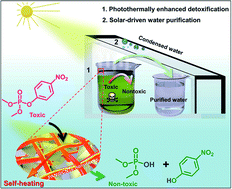Scalable and hierarchically designed MOF fabrics by netting MOFs into nanofiber networks for high-performance solar-driven water purification†
Abstract
Integrating metal–organic frameworks (MOFs) into flexible polymeric matrices can improve their practical processability and expand industrial applications greatly. However, current methods suffer from the serious aggregation of MOFs, low MOF loading, sacrifice of inherent pores in MOFs, and limited tunability of both MOFs and matrices. Herein, a novel net-fishing inspired strategy is developed for scalable and rapid production of high-performance MOF fabrics with tailored hierarchical architectures. It simultaneously realizes the good dispersion of individual MOF particles embedded into fishnet-like pores and achieves a maximum MOF loading of 85.7 wt%, while maintaining the inherent pore structures of the MOFs and enabling the convenient regulation of the functionality of the porous nanofibrous supports. Furthermore, a MOF fabric with UiO-66-NH2 particles and carbon nanotubes (CNTs) confined inside functionalized polyacrylonitrile (PAN) nanofiber scaffolds is presented for solar-driven production of potable water from chemical warfare agent (CWA) simulant sewage. As a result, a record-breaking half-life of dimethyl-4-nitrophenyl phosphate (DMNP) and a promising water generation rate (2.97 L m−2 d−1) are achieved. Owing to the versatility, our strategy provides a pioneering and fascinating platform for the future design of MOF fabrics with wide practical applications.

- This article is part of the themed collection: Journal of Materials Chemistry A HOT Papers


 Please wait while we load your content...
Please wait while we load your content...